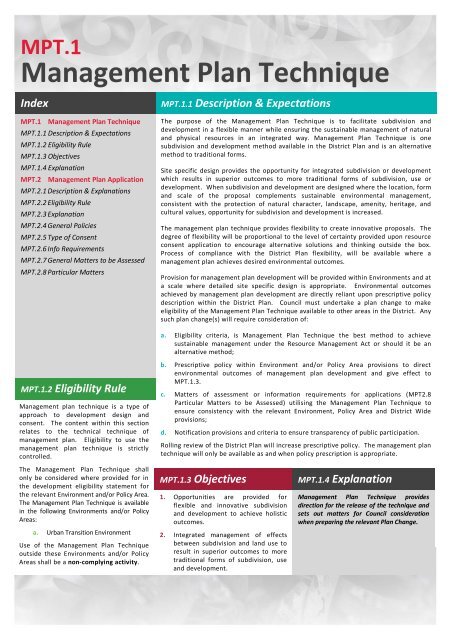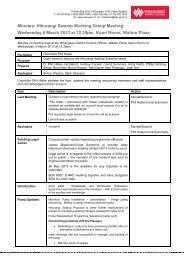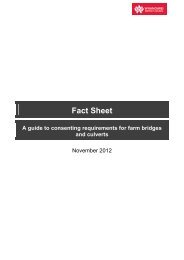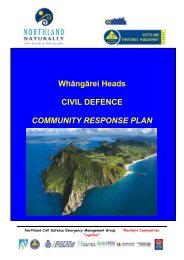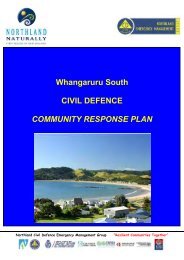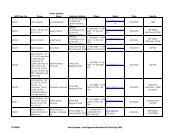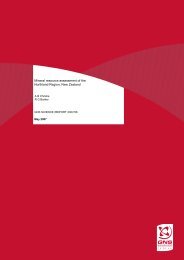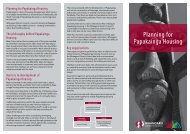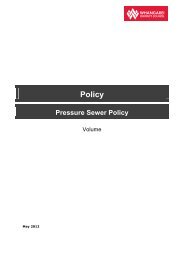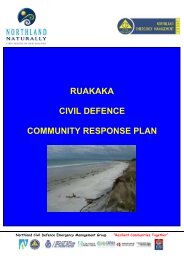MPT Management Plan Technique - Whangarei District Council
MPT Management Plan Technique - Whangarei District Council
MPT Management Plan Technique - Whangarei District Council
You also want an ePaper? Increase the reach of your titles
YUMPU automatically turns print PDFs into web optimized ePapers that Google loves.
<strong>MPT</strong>.1<strong>Management</strong> <strong>Plan</strong> <strong>Technique</strong>W hangareiIndex<strong>MPT</strong>.1<strong>Management</strong> <strong>Plan</strong> <strong>Technique</strong><strong>MPT</strong>.1.1 Description & Expectations<strong>MPT</strong>.1.2 Eligibility Rule<strong>MPT</strong>.1.3 Objectives<strong>MPT</strong>.1.4 Explanation<strong>MPT</strong>.2<strong>Management</strong> <strong>Plan</strong> Application<strong>MPT</strong>.2.1 Description & Explanations<strong>MPT</strong>.2.2 Eligibility Rule<strong>MPT</strong>.2.3 Explanation<strong>MPT</strong>.2.4 General Policies<strong>MPT</strong>.2.5 Type of Consent<strong>MPT</strong>.2.6 Info Requirements<strong>MPT</strong>.2.7 General Matters to be Assessed<strong>MPT</strong>.2.8 Particular Matters<strong>MPT</strong>.1.1 Description & ExpectationsThe purpose of the <strong>Management</strong> <strong>Plan</strong> <strong>Technique</strong> is to facilitate subdivision anddevelopment in a flexible manner while ensuring the sustainable management of naturaland physical resources in an integrated way. <strong>Management</strong> <strong>Plan</strong> <strong>Technique</strong> is onesubdivision and development method available in the <strong>District</strong> <strong>Plan</strong> and is an alternativemethod to traditional forms.Site specific design provides the opportunity for integrated subdivision or developmentwhich results in superior outcomes to more traditional forms of subdivision, use ordevelopment. When subdivision and development are designed where the location, formand scale of the proposal complements sustainable environmental management,consistent with the protection of natural character, landscape, amenity, heritage, andcultural values, opportunity for subdivision and development is increased.The management plan technique provides flexibility to create innovative proposals. Thedegree of flexibility will be proportional to the level of certainty provided upon resourceconsent application to encourage alternative solutions and thinking outside the box.Process of compliance with the <strong>District</strong> <strong>Plan</strong> flexibility, will be available where amanagement plan achieves desired environmental outcomes.Provision for management plan development will be provided within Environments and ata scale where detailed site specific design is appropriate. Environmental outcomesachieved by management plan development are directly reliant upon prescriptive policydescription within the <strong>District</strong> <strong>Plan</strong>. <strong>Council</strong> must undertake a plan change to makeeligibility of the <strong>Management</strong> <strong>Plan</strong> <strong>Technique</strong> available to other areas in the <strong>District</strong>. Anysuch plan change(s) will require consideration of:a. Eligibility criteria, is <strong>Management</strong> <strong>Plan</strong> <strong>Technique</strong> the best method to achievesustainable management under the Resource <strong>Management</strong> Act or should it be analternative method;<strong>MPT</strong>.1.2 Eligibility Rule<strong>Management</strong> plan technique is a type ofapproach to development design andconsent. The content within this sectionrelates to the technical technique ofmanagement plan. Eligibility to use themanagement plan technique is strictlycontrolled.The <strong>Management</strong> <strong>Plan</strong> <strong>Technique</strong> shallonly be considered where provided for inthe development eligibility statement forthe relevant Environment and/or Policy Area.The <strong>Management</strong> <strong>Plan</strong> <strong>Technique</strong> is availablein the following Environments and/or PolicyAreas:a. Urban Transition EnvironmentUse of the <strong>Management</strong> <strong>Plan</strong> <strong>Technique</strong>outside these Environments and/or PolicyAreas shall be a non‐complying activity.b. Prescriptive policy within Environment and/or Policy Area provisions to directenvironmental outcomes of management plan development and give effect to<strong>MPT</strong>.1.3.c. Matters of assessment or information requirements for applications (<strong>MPT</strong>2.8Particular Matters to be Assessed) utilising the <strong>Management</strong> <strong>Plan</strong> <strong>Technique</strong> toensure consistency with the relevant Environment, Policy Area and <strong>District</strong> Wideprovisions;d. Notification provisions and criteria to ensure transparency of public participation.Rolling review of the <strong>District</strong> <strong>Plan</strong> will increase prescriptive policy. The management plantechnique will only be available as and when policy prescription is appropriate.<strong>MPT</strong>.1.3 Objectives1. Opportunities are provided forflexible and innovative subdivisionand development to achieve holisticoutcomes.2. Integrated management of effectsbetween subdivision and land use toresult in superior outcomes to moretraditional forms of subdivision, useand development.<strong>MPT</strong>.1.4 Explanation<strong>Management</strong> <strong>Plan</strong> <strong>Technique</strong> providesdirection for the release of the technique andsets out matters for <strong>Council</strong> considerationwhen preparing the relevant <strong>Plan</strong> Change.
<strong>MPT</strong>.2<strong>Management</strong> <strong>Plan</strong> Application<strong>MPT</strong>.2.1 Description & ExpectationsThe purpose of management plan development is to facilitate subdivision and development in aflexible manner while ensuring the sustainable management of natural and physical resources inan integrated way.To achieve sustainable management of natural and physical resources, and a holistic approach tosite specific design, development shall recognise and avoid incompatible land use. Whereappropriate the potential for reverse sensitivity effects should be avoided, remedied ormitigated. To reduce cumulative or ad‐hoc development, the <strong>Management</strong> <strong>Plan</strong> <strong>Technique</strong>should be a one off method for site specific design.In rural and coastal areas subdivision, use and development shall preserve and where possibleenhance, restore and rehabilitate the character of the applicable Environment (zone) in regardto Section 6 matters of the Resource <strong>Management</strong> Act 1991, and shall avoid adverse effects asfar as practicable by using techniques including:a. clustering or grouping development within areas where there is the least impact on naturalcharacter and its elements such as indigenous vegetation, landforms, rivers, streams andwetlands, and coherent natural patterns;b. minimising the visual impact of buildings, development, and associated vegetationclearance and earthworks, particularly as seen from public land and the coastal marinearea;c. providing for, through siting of buildings and development and design of subdivisions, legalpublic right of access to and use of the foreshore and any esplanade areas;d. through siting of buildings and development, design of subdivisions, and provision of accessthat recognise and provide for the relationship of Maori with their culture, traditions andtaonga including concepts of mauri, tapu, mana, wehi and karakia and the importantcontribution Maori culture makes to the character of the <strong>District</strong>;e. providing planting of indigenous vegetation in a way that links existing habitats ofindigenous fauna and provides the opportunity for the extension, enhancement or creationof habitats for indigenous fauna, including mechanisms to exclude pests;f. protecting historic heritage through the siting of buildings and development and design ofsubdivisions.In urban areas and built environments subdivision, use and development shall avoid adverseeffects as far as practicable by using techniques including:a. Urban design principles developed in accordance with the New Zealand Urban DesignProtocol.b. <strong>Plan</strong>ning infrastructure framework incorporating alternative engineering solutions, wherepracticable, for:Note:• Roading;• Wastewater;• Stormwater;• Water;• Public open space.<strong>Management</strong> plans established and implemented under the provisions outlined in thischapter are different to Mineral Extraction <strong>Management</strong> <strong>Plan</strong>s as provided for inChapter 64 of the <strong>District</strong> <strong>Plan</strong>.<strong>MPT</strong>.2.2 Eligibility RuleAny resource consent application utilising the <strong>Management</strong> <strong>Plan</strong> <strong>Technique</strong> shall comply withprovisions <strong>MPT</strong>.2.4 to <strong>MPT</strong>.2.8<strong>MPT</strong>.2.3 Explanation<strong>Management</strong> <strong>Plan</strong> Application providesdirection for the assessment of resourceconsent applications utilising the<strong>Management</strong> <strong>Plan</strong> <strong>Technique</strong> and sets outmatters for <strong>Council</strong> consideration.<strong>MPT</strong>.2.4 General Policies1. To avoid physical site constraints whendesigning subdivision and developmenton a site specific basis, where mitigationand remediation will not result insustainable management.2. To provide for flexible and innovative,implementation of subdivision anddevelopment to achieve superioroutcomes.3. To ensure that the management plan willprovide for the ongoing management ofthe sites to achieve sound resourcemanagement.4. To integrate the management of effectsbetween subdivision and land use, viamanagement plan conditions.5. To require robust preparation andassessment process of integratedsubdivision and development.6. To ensure that all matters relating toinfrastructure servicing and engineeringshall be designed consistent with theoutcomes sought by EnvironmentalEngineering Standards 2010.7. To recognise, maintain and enhance theunique characteristics and attributes ofthe surrounding environment as indicatedby way of Overlay and Policy Areas on the<strong>Plan</strong>ning Maps.8. To ensure subdivision and development ofland is provided for in such a way as willbe consistent with the <strong>District</strong> wideprovisions and purpose of the variousEnvironments in the <strong>Plan</strong>.9. To ensure subdivision and developmentrecognise and provide for any relevantstructure plan.10. To ensure subdivision and developmenthas particular regard to adjacent landdevelopment activities.11. Subdivision and development of landundertaken on a site specific basis shallrecognise and avoid the potential forreverse sensitivity effects.
<strong>MPT</strong>.2<strong>Management</strong> <strong>Plan</strong> Application<strong>MPT</strong>.2.5 Type of Consent<strong>Management</strong> <strong>Plan</strong> <strong>Technique</strong> is a type of approach to development design and consent.Resource consent applications made under the <strong>Management</strong> <strong>Plan</strong> <strong>Technique</strong> provisions shall beconsidered as a land use consent, unless combined land use and subdivision consent is expresslyrequested.Activity status of any resource consent application made under the <strong>Management</strong> <strong>Plan</strong> <strong>Technique</strong>provisions shall be determined by the relevant <strong>District</strong> Wide, Environment and/or Policy Areaprovisions.Resource consent granted under the <strong>Management</strong> <strong>Plan</strong> <strong>Technique</strong> shall be considered to be‘given effect to’ when the <strong>Council</strong> approved management plan is registered against theCertificate of Title of the subject site.Once a land use consent has been approved by <strong>Council</strong> under the <strong>Management</strong> <strong>Plan</strong> <strong>Technique</strong>provisions, any future subdivision of the subject site will require separate approval from <strong>Council</strong>.The future subdivision shall be considered as a permitted activity subject to Certificate ofCompliance certification in accordance with Section 139 of the Resource <strong>Management</strong> Act 1991where the subdivision is in accordance with a <strong>Council</strong> approved management plan, registeredagainst the Certificate of Title.Any proposed activity that does not comply with an approved <strong>Management</strong> <strong>Plan</strong> that has beengiven effect to, is a non‐complying activity and will require resource consent approval under therelevant <strong>District</strong> Wide, Environment and/or Policy Area provisions.<strong>MPT</strong>.2.7 General Matters to be AssessedAll applications for consent using the management plan technique shall be assessed against thefollowing general matters:1. Adequacy of compliance with the prescribed management plan form.2. Adequacy of the management plan including and not limited to the:• on‐going compliance provisions prescribed within the management plan;• method of registration proposed to give effect to the management plan;• extent to which physical site constraints have been taken into account;• development proposal and consent timing and/or staging;• method of compliance provisions prescribed within the management plan to meetrequirements of Sections, 108, 220, 223 and 224 of the Resource <strong>Management</strong> Act,where future subdivision is considered.• Clarification of development flexibility within the realm of the management plan(triggers to alternative consent requirements)3. Compliance with the management plan development eligibility requirement for the relevantEnvironment and/or Policy Area.4. Fulfilment of the development standards for the relevant Environment and/or Policy Areaand <strong>District</strong> Wide Rules.5. Fulfilment of any relevant <strong>District</strong> Wide, Environment and/or Policy Area objectives andpolicies.6. Consideration of the provisions of any relevant structure plan that has been prepared forthe locality.7. Consideration of and cognisance with provisions and proposals of other management planon an adjoining property8. Whether bonds are necessary to assist in achieving the management plan.9. The extent to which information and proposed management measures are provided bysuitably qualified persons.10. The extent to which reverse sensitivity effects on existing environment are avoided,remedied or mitigated.11. Consideration of designations, including where applicable, written approvals pursuant toSection 176 of the Resource <strong>Management</strong> Act.<strong>MPT</strong>.2.6 Info RequirementsAll applications for consent using themanagement plan technique shall include, inaddition to the standard information requiredunder Schedule 4 of the Resource<strong>Management</strong> Act 1991, the followinginformation:1. Any information required to assess theproposal against relevant developmenteligibility, objectives and policies.2. Draft <strong>Management</strong> <strong>Plan</strong>, completed inthe <strong>Council</strong>’s prescribed form andmanner (to be finalised in accordancewith the conditions of consent) settingout, the extent relevant to the proposal;a. the objectives of the proposal(managing expectations);b. the mechanisms to ensure that themanagement plan applies to andbinds future owners;c. proposals for staging ofdevelopment including, where asubdivision is to be staged,arrangements for vesting anyreserves, access facilities (vehicleand pedestrian) or public utilitiesrequired by the resource consentand located in subsequent stages.3. Any additional information <strong>Council</strong> mayrequire on aspects of the proposal.<strong>MPT</strong>.2.8 Particular MattersAll applications for consent using themanagement plan technique shall be assessedagainst the following particular matters:1. Urban Transition Environment:a. Appropriateness of UTE.2.1Discretionary Activities;b. Appropriateness of commercial orindustrial activities.c. The effects of the development onexisting local roads and Statehighways, including intersections, byway of a Traffic Impact Assessment.


